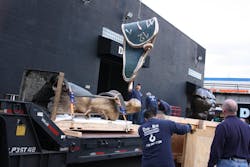For Anthony Conetta, no two days are alike. And that’s what he likes most about his job.
Conetta is the vice president and controller of Dun-Rite Specialized Carriers, a Bronx, NY-based, family-owned moving and trucking business that specializes in transporting and installing fine art – from multi-million dollar paintings for private homes or public museums to an 80-ft. structure at JFK Airport.“It’s different every day,” Conetta said. “It’s great hearing the stories behind the pieces – about how someone bought a piece years ago, and now they are moving. You get to hear the side of art that you’re not able to read or learn about otherwise.”
Since 1954, Dun-Rite has been a hoisting, rigging and carrying company that specializes in packing, crating, storing and moving oversized freight. But it really began to develop its niche in the art world after it was first hired by Steinway Pianos, Conetta said.
Dun-Rite’s client base stretches across the tri-state area and through most of New York City. Conetta said Dun-Rite also has served clients in the middle of the country and as far as Europe; however, 60% of its business resides in New York City.
Some of the company’s projects include moving the Garibaldi Monument at Washington Square Park; Park Avenue installations and de-installations; installing and de-installing the sculptures in Nevelson Plaza; transporting and setting up over a dozen sculptures on Governor’s Island in New York, which Conetta said had to be transported by trucks and barge; and relocating artist Alice Aycock’s “Star Sifter,” an 80-ft. piece that had to be suspended 100 ft. in the air, in JFK Terminal 1. Dun-Rite has also been hired by museums, galleries, foundations, auction houses and private residents to move sculptures, paintings and other pieces of art.
Because many of the pieces Dun-Rite has moved cost as much as some of the multi-million dollar buildings that house them, Conetta said, the company uses specialized equipment and must follow customized insurance requirements. To keep the artwork secure, everything is crated or contained, depending on the material, he explained.
Dun-Rite uses a 40-ton crane if a job requires hoisting on the rear or side of a building; a one-ton custom rooftop Derrick that is set up on rooftops and can be taken apart without becoming invasive to the buildings; and a fleet that includes roll offs, flatbeds, trailers, open tops, and climate-controlled trucks to transport and protect delicate pieces and paintings. The company has a temperature-controlled, on-site storage facility and warehouse to house and protect certain pieces before they are transported. In addition, Dun-Rite has a full wood shop on premise so it can ship internationally.
The company is insured, but Conetta said if an item is lost or stolen, insurance companies will conduct a thorough investigation into the company’s protection protocols. And if a piece were to become damaged during the moving process, Conetta said Dun-Rite would call a restoration expert to restore it.
“Luckily we’ve never had to find out what happens if a piece is lost, damaged or stolen,” Conetta said. “Hopefully we never will.”
Dun-Rite also holds master riggers and special riggers licenses with New York City. Conetta said the company has two licensed crane operators on staff and is certified by the National Commission for the Certification of Crane Operations, which is required for signaling cranes.
“Many paintings and the pieces we handle have gotten to the point of tremendous expense in the art world,” Conetta said. “The fun thing is the value of the art keeps increasing. Our insurance amounts and limits are customized for our business. Everyone wants to be fully insured for everything in the city now – from terrorist acts to acts of nature.”
But after everything is said and done and after all the protocols have been met, it’s the personal stories behind the artwork and the unique pieces the company handles that make the job interesting.
“We have a good team, and we have a lot of fun,” Conetta said. “It’s always challenging and fun. There’s always a good laugh somewhere along the line. There are so many interesting stories to share – that’s what keeps us doing what we do.”About the Author

Cristina Commendatore
Cristina Commendatore is a past FleetOwner editor-in-chief. She wrote for the publication from 2015 to 2023.
